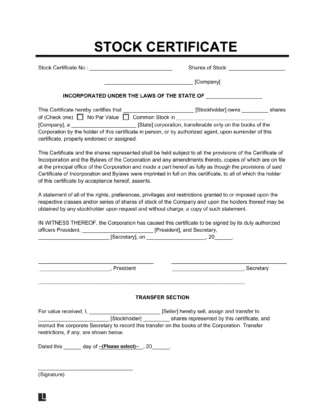
Use our stock certificate to prove that an investor owns stock in a company.

Updated December 4, 2023
Written by Sara Hostelley | Reviewed by Brooke Davis
A stock certificate is a document that proves ownership of a certain number of stocks or shares. Even though most companies issue stocks digitally, some investors prefer to have a paper trail, which this document can provide.
A stock certificate is a legal document proving and recording ownership of a certain number of shares of stock in a corporation. The authorized officers of the corporation, usually the president and the secretary, should sign the share certificate to validate it.
With proof of ownership, the shareholder can get access to annual reports, declare dividends, and receive invitations to shareholder meetings. Additionally, holding a physical copy of the certificate may make it easier for the investor to get a loan on the value of the shares owned.
Companies issue stock certificates to prove a shareholder owns a stock. Smaller companies with limited shareholders or investors tend to issue paper stock certificates.
A stock certificate contains the following essential elements:
Here are some other useful details a certificate of stock might include:
Consider the following when creating your corporate stock certificate:
Corporations issue stock to expand and grow their operations. Issuing stock can help them raise capital to fulfill the following goals:
Shareholders can purchase stock and receive corporate stock certificates via the following methods:
An investor can open a brokerage account and deposit funds. Then, when they find a company they want to become a partial owner of, they can place buy orders for the relevant stocks.
Most brokerage transactions are electronic, so shareholders won’t receive a physical stock certificate automatically. However, they can request one in some cases for a small fee.
An aspiring shareholder can go directly through the issuing company to purchase stock. This way, an investor doesn’t have to go through a brokerage, meaning they might be able to save on transaction fees.
The company that issued stock may distribute paper certificates to its shareholders upon request.
If a shareholder already owns stocks digitally, they may be able to request paper certificates from a transfer agent. This individual maintains stock records and can assist with issuing a paper copy.
Here are some options you have when dealing with old stock certificates:
Check the value of an old stock certificate by researching the issuing company’s status. Determine if it has undergone mergers or acquisitions, as these events can impact the certificate’s value.
You may also consult with a financial advisor who can provide insight into the document’s value. If you discover it has some monetary value, you can initiate a sale or transfer it to a form of digital proof.
If a stock certificate is from a company that’s no longer operational, you don’t have to throw away your certificate immediately. In fact, it may have value as a collectible item. You may consider framing it to preserve its condition. You may also donate the document to an institution that stores educational or historical artifacts.
If you misplaced an old certificate and aren’t sure of its value, you can check with your state’s unclaimed property division. If someone turns over a lost stock certificate to the state, you may be able to reclaim its value and any associated dividends.
Review our free stock certificate template to record a shareholder’s ownership of company stock. Download it as a PDF or Word file below: